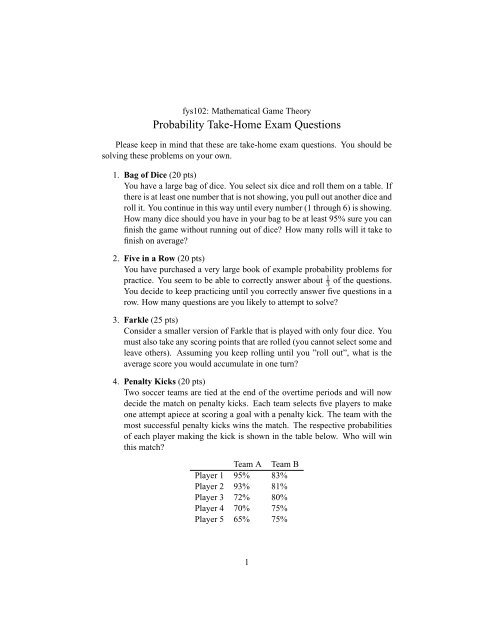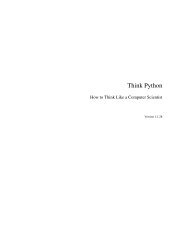Probability Take-Home Exam Questions
Probability Take-Home Exam Questions
Probability Take-Home Exam Questions
- No tags were found...
Create successful ePaper yourself
Turn your PDF publications into a flip-book with our unique Google optimized e-Paper software.
fys102: Mathematical Game Theory<strong>Probability</strong> <strong>Take</strong>-<strong>Home</strong> <strong>Exam</strong> <strong>Questions</strong>Please keep in mind that these are take-home exam questions. You should besolving these problems on your own.1. Bag of Dice (20 pts)You have a large bag of dice. You select six dice and roll them on a table. Ifthere is at least one number that is not showing, you pull out another dice androll it. You continue in this way until every number (1 through 6) is showing.How many dice should you have in your bag to be at least 95% sure you canfinish the game without running out of dice? How many rolls will it take tofinish on average?2. Five in a Row (20 pts)You have purchased a very large book of example probability problems forpractice. You seem to be able to correctly answer about 1 3of the questions.You decide to keep practicing until you correctly answer five questions in arow. How many questions are you likely to attempt to solve?3. Farkle (25 pts)Consider a smaller version of Farkle that is played with only four dice. Youmust also take any scoring points that are rolled (you cannot select some andleave others). Assuming you keep rolling until you ”roll out”, what is theaverage score you would accumulate in one turn?4. Penalty Kicks (20 pts)Two soccer teams are tied at the end of the overtime periods and will nowdecide the match on penalty kicks. Each team selects five players to makeone attempt apiece at scoring a goal with a penalty kick. The team with themost successful penalty kicks wins the match. The respective probabilitiesof each player making the kick is shown in the table below. Who will winthis match?Team A Team BPlayer 1 95% 83%Player 2 93% 81%Player 3 72% 80%Player 4 70% 75%Player 5 65% 75%1
5. Coffee Contest (20pts)A group of n people meet at lunch for a cup of coffee. They play a game tosee who gets to pay for all the coffees. Each person flips a coin. If all thecoins come up the same except for one person, then that one person gets topay for all the coffee. If the coins do not result in this way, then everyoneflips again until there is exactly one person different. Obviously, the gamedoesn’t work for less than three people. Also, as n grows large it may takemany flips to decide the loser of the game.(a) For n = 3 people, how many flips will it take on average to find awinner?(b) For n = 10 people, how many flips will it take on average to find awinner?(c) Find a general formula that computes the average number of flips as afunction of n. Create a graph for n = 3...20 showing the number ofrequired flips.6. Chutes and Ladders (25 pts)Milton Bradley manufactures a children’s board game called ”Chutes andLadders”. They want to figure out if the game is too difficult for youngchildren; in particular, will the game last too long for the average child’sattention span? Studies indicate that young children of the age appropriatefor this game will be willing to play for approximately 15 minutes beforebecoming bored. To be safe, Milton Bradley wants to ensure that the averagegame of Chutes and Ladders lasts less than 12 minutes. They havealso determined that the average turn in the game takes about 7 seconds. Ashead mathematician at Milton Bradley, your job is to determine if the averagegame can be completed in less than 12 minutes.7. Birthdays in the Crowd (25 pts)Consider a room with n people. Assume there are 365 days in the year(ignore leap years).2
(a) If you want to find a person with the same birthday as yours, what isthe minimum number of strangers you must ask in order to have at leasta 50% chance of finding someone else with your birthday?(b) What is the probability that any two or more people share the samebirthday?(c) How many people must be present in order to have at least 50% chancethat two or more people have matching birthdays?8. Mr. Wobbly (30 pts)Mr Wobbly is a robot. You place Mr. Wobbly on a 3×3 tic-tac-toe board inthe middle square. Each second, Mr Wobbly moves one square either left,right, up, or down. Assume that Mr. Wobbly does this in a random fashion.How many seconds will Mr. Wobbly take to fall off the edge of the board onaverage?9. Plinko (30 pts)Plinko is a game from the Price is Right television show. A Plinko gameboard is shown in Figure 1. A contestant receives a disk which is placed atthe top of the board in one of the nine slots ( the slots are numbered S1..S9).The disk then falls downward as it moves its way between the rows of pegs.Eventually the disk drops into one of the nine reward bins at the bottom(numbered R1..R9). There is a payoff associated with each reward bin. Onthe original Price is Right show, the rewards are:Reward Bin R1 R2 R3 R4 R5 R6 R7 R8 R9Prize $100 $500 $1000 $0 $5000 $0 $1000 $500 $100Assume that when a disk falls between two pegs it is equally likely to fallto the right or left of the next peg it immediately encounters. The disk willnever skip to any other “slot” further to the left or right. Of course a disk thatencounters a bumper on one of the “side wall slots” will always fall backtoward the middle of the game.(a) What is the best strategy (Slot 1 ... Slot 9) for your Plinko chip?3
S1S2S3 S4 S5 S6 S7S8S9R1 R2 R3 R4 R5 R6 R7R8R9Figure 1: A Plinko Board(b) What is the expected value of your Plinko chip (for the optimal slot)?10. Tournament of Luck (30 pts)Each year, very lucky people from all over the world assemble in Las Vegasto determine who is the luckiest of all. Assume there are 8 players inthe tournament. The players are initially randomly paired in a tournamentbracket as shown below:1. ----2. ----3. ----4. ----5. ----6. ----7. ----8. -------------------------------- ( tournament winner )For each match the referee flips a coin to determine the winner. The losers4
are eliminated and the winners continue to the next round to compete againstother winners.(a) If two sisters are among the eight entrants, what is the probability thatthey compete against each other at some point during the tournament?(b) Instead of 8 players, assume there are 2 n players for some value of n.Find a formula for the probability that the two sisters will meet eachother in this tournament.(c) Use your formula from part (b) to find the probability that two sistersmeet up somewhere in a contest with 1024 people.11. Birthday Holidays (35 pts)Game theory class is so interesting that they decide to meet every single dayof the year. Every day they meet, each person in the class works on and thensolves a new problem. However, if anyone in the class has a birthday onthat particular day, they all take a break and have a party instead. How manypeople should be permitted in the game theory class if the professor wants tomaximize the total expected number of newly solved problems for the wholeyear?Note this problem requires basic calculus skills.12. Price is Right Wheel (35 pts)The Price is Right television game show has a big spin-off wheel to see whogets in the show-case show down. Three contestants take turns spinning thewheel which have 20 spaces with amounts of $0.05 to $1.00 in five-cent increments.Each contestant is allowed one or two spins where the goal is tohave the largest total amount that does not exceed $1.The first person must often decide whether they want to spin again and riskgoing over a dollar, or trying to get a higher total sum. What is the optimalstrategy for the first player (i.e., what dollar amount should they stay versusspin again)? Answer this problem for only two contestants (it is easier thanconsidering all three).13. Two Urns (35 pts)There are two urns. Urn A contains 2 red balls and 1 black ball. Urn Bcontains 101 red balls and 100 black balls. You do not know which urn iswhich. Your goal is to select two balls from the same urn and then guess5
from which urn you selected. However, you have the choice of replacing thefirst ball you selected before selecting the second, or keeping the first ballout and selecting a second ball from that same urn.What is your best strategy (with regards to replacing the first ball or keepingit out) to maximize your chances of guessing the urn correctly?14. Survivor Tribal Council (35 pts)In the tv reality game show of Survivor, tribes must regularly attend tribalcouncil where they vote to remove one of their members from the tribe andfrom the game. Let’s assume that two members have received all the votes.There are a votes for Person A and b votes for Person B where a > b. ThusPerson A will be voted off the island.The host, Jeff Probst, reads the ballots one at a time to add excitement to theconclusion. Assume that he pulls the ballots randomly from the box. Whatis the probability that the vote count is tied at some point after the first ballothas been read?15. Survivor Fix (45 pts)Read the above question about voting in Survivor. If you have watched thisshow regularly, there seems to be an unusually large number of ties when thevotes are read ”in a random order”. That last vote always seems to be the decidingfactor. Certainly the producers cannot alter the votes since that wouldviolate the integrity of the game. However, it is rumored that the order inwhich the ballots are read is not random and that the order is selected to addextra suspense to the last vote.Research the vote-reading outcomes from the previous Survivor episodesand then determine the probability that the order is purposely manipulated toadd more drama for the tv viewing audience.This will require some additional reading material in Bayesian analysis andalso some time invested in researching survivor voting.6
















